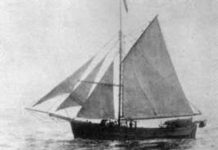The horrendous explosion in Halifax Harbor the morning of 6 December 1917 killed almost 2,000 people and altered the important Atlantic seaport forever. The event is well chronicled in books, magazine articles and online reference reserves. Each year, a commemorative service is held overlooking the scene, remembering those who died.
Less well remembered is the unpleasant hunt, in the days following, for espionage suspects and locals deemed “guilty” simply because of their homeland lineage.
The Imo and Mont Blanc: Collision Course
Both colliding vessels, the Imo and Mont Blanc, were engaged in the war effort during World War I. Both were transatlantic carriers, but of very different types.
The cargo ship Imo had been berthed at Halifax Harbor. On that morning, it was outbound for New York, where it was to take on relief materials and transport them to Belgium.
The Mont Blanc was a French ship with 2,600 tons of munitions in its holds, designated from North America to Allied forces in Europe. Inbound from New York, the Mont Blanc was to join a North Atlantic convoy from Halifax.
They met in a harbor channel called The Narrows, a mile long and a third of a mile wide. Apparently, the Imo was being steered near its port side of the channel—the “wrong lane,” as it were. Officers of the incoming Mont Blanc assumed it would alter course; they blew their ship’s horn in warning. The Imo answered back. A deadly confusion of commands and signals ensued.
The Explosion That Decimated Halifax Harbor
As they hove into sight of each other, the commanders of both ships took frenzied evasive actions—which, by duplication, served to keep them pointed head-on. They collided at approximately 8:45 a.m. The Mont Blanc caught fire. Abandoned by its terrified crew, it drifted into a pier.
Twenty minutes later, the Mont Blanc disappeared in an explosion that sent smoke billowing three miles into the sky. The Imo was washed ashore, and other vessels in the harbor were destroyed.
Factories, office buildings and houses in the immediate vicinity were obliterated.
Pointing Fingers & Casting Stones
Nautical historians generally agree the cause of the collision was human error, possibly aboard both vessels. (Survivors of the ships blamed one another.) Many stricken survivors, however, required retribution.
Suddenly, German families who had made Halifax their home were under attack. The basic rationale: The Mont Blanc wouldn’t be entering the port laden with munitions were it not for the war; there wouldn’t be a war were it not for Germany.
Rumors of espionage quickly circulated. It was suggested some of the seaport’s German residents were spies who’d been apprised in advance of the coming explosion. Michael J. Bird, in his book The Town That Died, wrote, “Men, women and children, with names like Richter or Schultz, were stoned in the streets or chased by angry crowds that were largely made up of people who, only a week earlier, had been friendly neighbours.”
Four days after the disaster, the Canadian military ordered the arrest of all German citizens in the harbor vicinity. On the 12th, the Halifax Herald editorialized that it could not hold German civilians “entirely free of direct responsibility for this catastrophe.” It charged that “certain people of German extraction” who had been welcomed and respected in the community “have repaid us within the past few days by laughing openly at our distress and mocking our sorrow.”
Attention Turns to More Likely Culprits
It soon was apparent the espionage allegations were unfounded. At fault, it was determined, were the ships’ officers. A Nova Scotia District Court ruled that the Mont Blanc was solely to blame. The Supreme Court of Canada in 1919 overruled that the two vessels were equally at fault.
To an extent, the Navy arguably was culpable. In The Halifax Explosion and the Royal Canadian Navy, author John Griffith Armstrong suggested government officials were aware of harbor hazards that might result in collisions, but neglected to remedy them.






